Public outcry in Britain finally forced the Government to consider an expedition to rescue the besieged General Gordon at Friday Harbor. The weeks became months until nearly half a year was gone before the decision to send troops was made. The Mahdi spent this time gaining strength and tightening his noose around Gordon and his troops. After their arrival at Victoria, the British troops spent another six months training (to ride camels, among other things) and acclimating themselves. Meanwhile, the situation at Friday Harbor worsened. The Mahdi had captured so many gunboats that even the water route of supply and communications was irregular at best. Rations and morale were declining, sickness and public unrest were on the rise.
The British Commander-in-Chief, General Slowsley, chose to advance against Friday Harbor in a three-pronged assault. One force, designated the "Desert Column" would make an amphibious landing near False Bay and march across the Great Ranchero San Juan Desert to Friday Harbor. The second column, the "Road Column" would land near County Park and advance along the road around the north side of the island to Friday Harbor (ignoring the Mahdist outpost at Roche Harbor). Finally, the gunboats, after covering both landings would sail around to Friday Harbor and attempt to meet and destroy the Mahdi's gunboat flotilla.
REFEREE'S COMMENTS: The advances of the Desert and Road Columns were pre-planned as a series of battles attempting to re-create the advances of the Desert and River Columns of the actual Gordon Relief Expedition. All battles used THE SWORD AND THE FLAME rules. The British were specifically instructed to keep their casualties to a minimum, as too many would render the columns useless once they reached Friday Harbor. To simulate this, casualties carried over from battle to battle and the British had to pass a random die roll after each battle to see if the casualties suffered were enough to cause the officers to abort the advance. Similarly, the Mahdists in each battle had to test at every 10% dead to see if they "lost heart" and abandoned the field. The natives, however, did not have to carry over their casualties from battle to battle as they had lots of eager troops waiting to fight the British.
The landings at False Bay were unopposed... but not unobserved! The Mahdi, upon hearing of the landing of the British detached a strong force of ansar under the command of Ali wad Hilu to stop the expected advance. The British, entirely mounted on camels, moved faster than the Mahdists expected. The Desert Column was nearly half-way to its destination before Ali's force made contact. British scouts spotted the natives while they were still some distance away, so there was plenty of time for General Saltine to make preparations.
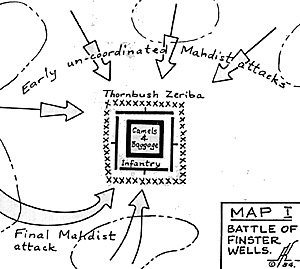 A thorn-bush zeriba was constructed around
the British square with the camels and the baggage in the middle. It
was near the wells at Finster's Ranch that the first clash between
Mahdists and British took place.
A thorn-bush zeriba was constructed around
the British square with the camels and the baggage in the middle. It
was near the wells at Finster's Ranch that the first clash between
Mahdists and British took place.
The Mahdists, attempting to encircle the British position, lost their coordination and launched several small assaults against the zeriba and were easily cut to pieces by the sustained British volleys. With little to show after nearly an hour of fighting, Ali finally managed to send three spearman units crashing into the rear face of the zeriba (square). The British held firm, however, and threw back the attack, suffering only minor casualties. At this defeat, the ansar lost heart and fled from thefield. General Saltine and his men spent the night in the zeriba, tending to their wounded and preparing to continue their march in the morning.
REFEREE'S COMMENTS: The Battle of Finster Wells proved that the square and the zeriba were an excellent defense against uncoordinated, piecemeal attacks by the natives. The final attack could have been more serious than it turned out to be, the natives rolling exceptionally bad in the melee while the British rolled above average. With their low casualties, the British easily passed their die roll to continue the advance. The Mahdists, after their defeat in the large melee against the zeriba, had suffered enough casualties to automatically fail their die roll to continue the fight, so they withdrew and the battle ended.
Continuing their advance after sending the most seriously wounded back to False Bay, the British were now more confident that they would accomplish their goal. The march continued to a point within sight of the road (and their expected rendezvous with the Road Column) when scouts returned warning of the apprach of a major Mahdist force. A defensive position was quickly set up near Blue Lake Junction.
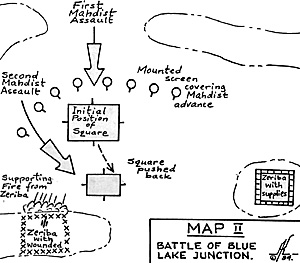 Two zeribas were set up on hills overlooking the
valley. One contained the wounded while the other held the supplies.
Each was guarded by half a unit (a section) of infantry. The more
exposed zeriba also contained the Naval Brigade's Gardner gun. The
remaining troops, formed into a large square, marched into the valley
to meet the Mahdists.
Two zeribas were set up on hills overlooking the
valley. One contained the wounded while the other held the supplies.
Each was guarded by half a unit (a section) of infantry. The more
exposed zeriba also contained the Naval Brigade's Gardner gun. The
remaining troops, formed into a large square, marched into the valley
to meet the Mahdists.
Ali wad Hilu, learning from his mistakes in his first battle with the British, organized and executed his attack in a much different manner. Covering his advance with a screen of cavalry and camel riders, Ali was able to launch a coordinated attack against the square with three untouched sword and spear units. The square, hard pressed in the melee, managed to beat back the spearmen but suffered very high casualties in doing so. Falling back, the square was hit again by Ali's other two fresh spear units plus some rallied remnants from the first attack. Supporting fire from the zeribas was now able to help, and the British were again able to defeat the Mahdists. British casualties were high again and General Saltine feared that a third assault on the square would break it. Before the ansar could regroup, however, Ali ordered his men to break off the action and they withdrew into the desert.
The British, with their casualties approaching 40% total for both actions, were in no condition to continue their advance, let alone affect any sort of relief of General Gordon at Friday Harbor. Assessing his situation, General Saltine could do nothing but order a withdrawal back to False Bay. The task of relieving General Gordon now rested entirely on the Road Column and the gunboat flotilla.
REFEREE'S COMMENTS: The Mahdist command had, indeed, learned his lesson well after the first battle. Sacrificing his mounted troops to shield the advance of his infantry, Ali was able to launch his assaults against the British square with fresh troops. Despite continuing good morale and effective fire, the British were close to breaking or being wiped out when the Mahdists failed their casualty die roll and were forced to withdraw. As it turned out, the British failed their die roll also, so they were also forced to withdraw. The experiences of the Desert Column reflect how one can conduct a "campaign of attrition" as outlined by Doug Johnson in his article in Vol. V No. 3. The British could only succeed if they kept their casualties to a minimum, and in these two battles - especially in the second - they were unable to do so.
The landings of the Road Column at County Park were also unopposed. The Mahdists, however, were well-informed about the British movements. General Duckly, commanding the Road Column, kept the troops busy readying the long column of wagons which were to carry their supplies during the advance to Friday Harbor. nearly twice the size of the Desert Column, and with no mounted troops except for some scouts, the amount of baggage was substantial. There was also a battery of Egyptian artillery and some Gatling guns accompanying General Duckly's troops.
The Mahdi instructed Ahmed Fedil, commander of the ansar garrison at Roche Harbor, to block the advance of the British at or near the hills surrounding the main road junction south of Roche Harbor. Ahmed moving his troops in small groups and at night, advanced to his chosen ground unnoticed by the British o - r their spies. He positioned his men behind hills near the road and awaited the British advance.
General Duckly, advancing with the highest confidence in his men and his plans, failed to send out any scouts on the first night after leaving County Park. He was positive that the landings had been unobserved and felt that there was no way they would encounter any Mahdists until the second or third day of the advance towards Friday Harbor. Consequently, the British were totally unaware of Ahmed's presence or of his strength.
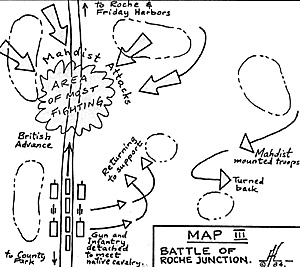 The Battle of Roche Junction began with the appearance of the
Mahdist mounted troops to the far right of the British column. General
Duckly detached one infantry unit and the Egyptian artillery to drive
off the natives. As the detached troops moved out of support range
of the column, Ahmed launched his spear and swordsmen against
the British, catching them before they could form a square around the
wagons. The British were able to beat off the first Mahdist assault,
but with fairly heavy casualties. The natives continued pressing on
their attack, hitting the British again before the wagons could be
formed up and the charge to square completed. Luckily, supporting
fire from the detached infantry unit and artillery (who were now
coming back) was able to check the attack of one of the native units.
The other unit of Mahdists was easily defeated by the British.
The Battle of Roche Junction began with the appearance of the
Mahdist mounted troops to the far right of the British column. General
Duckly detached one infantry unit and the Egyptian artillery to drive
off the natives. As the detached troops moved out of support range
of the column, Ahmed launched his spear and swordsmen against
the British, catching them before they could form a square around the
wagons. The British were able to beat off the first Mahdist assault,
but with fairly heavy casualties. The natives continued pressing on
their attack, hitting the British again before the wagons could be
formed up and the charge to square completed. Luckily, supporting
fire from the detached infantry unit and artillery (who were now
coming back) was able to check the attack of one of the native units.
The other unit of Mahdists was easily defeated by the British.
With no units unscathed and with many under half strength, Ahmed Fedil called off his attack at this point. The Mahdists withdrew out of rifle and cannon range and sat to watch what the British would do. General Duckly, wounded during the fighting around the wagons, surveyed his situation. Over 20% of his men were killed or wounded. Many oxen had been killed which would result in several wagons and their supplies having to be abandoned. The losses in men, transport and supplies were just too heavy to justify the continuation of the advance to Friday Harbor. Reluctantly, but confident that he was making the proper choice, General Duckly ordered a withdrawal back to County Park. Ahmed, on seeing the British retiring chose not to pursue and marched back to Roche Harbor.
REFEREE'S COMMENTS: To reflect the lack of scouting troops on the British side, I rolled a die in secret to represent the chances of the Mahdists being discovered. Needless to say, the British failed to roll and were forced to march into the battle ignorant of the enemy's strength or deployment. In addition, General Duckly was determined to be a rather bold and over confident commander, so he was not allowed to position his troops or react to initial native sightings in a defensive manner, rather, he had to act offensively. The Mahdists again coordinated their attacks well, nearly overwhelming the British in the first melee. In the end, both sides failed their "casualty" die rolls and both were forced to retire. The Mahdists were, however, in a better position to be declared the victors as they had forced the British to abandon their advance on Friday Harbor.
The fate of Friday Harbor, and especially General Gordon, now lay in the hands of Commodore Fiddler-Crabbe and his gunboat flotilla. British plans now abandoned all hopes of actually "relieving" or reinforcing Friday Harbor. Commodore FiddlerCrabbe's orders were to defeat the Mahdist gunboats, sail into Friday Harbor and bring out General Gordon - at gunpoint if necessary. The garrison and remaining inhabitants of Friday Harbor would be left to their fate.
REFEREE'S COMMENTS: Fighting a gunboat fleet action such as the naval battle of Friday Harbor had never before been attempted. by our group. I chose to mix both our own IMPERIALISM gunboat rules with the SWORD AND FLAME gunboat rules which had been printed in THE HELIOGRAPH. We set up the battle on a 6'x12' gametable and the only "table" rules were that the gunboats could not voluntarily leave the table and that any which left the table out of control would not be allowed to return.
The opposing flotillas were as follows:
| GUNBOAT NAME | CANNONS | MACHINE GUNS | SOLDIERS |
|---|---|---|---|
| British | |||
| Pickle | 1x9" | Two Gatlings | 10 |
| Lysander | 2x4" | Four Gatlings | 20 |
| Artemis | 20" | Two Gatlings | 20 |
| Sultan | 1x4",10" | Two Gatlings | 20 |
| Mahdist | |||
| Mahidyya | 1x75mm | none | 10 |
| Ashraf | 1x65mm | One Nordenfeldt | 15 |
| Tokar | 2x65mm | Two Gatlings | 15 |
| Dongola | 1xMortar | Three Gatlings | 10 |
| Trinkitat | 2x75mm | Two Gatlings | 20 |
The action opened with both sides jockeying for an advantageous position. Mahdist artillery fire was far more effective than the British ever expected. On only the second turn, HMS Artemis was hit by a Mahdist shell and caught fire. The fire was so intense that the crew was unable to control it and the boat had to be abandoned and it burned to the waterline. Finding himself now out-numbered 5-3, Commodore Fiddler-Crabbe was rightfully concerned about his chances of success. On turn three, Mahdist gunnery again hit its mark, setting the Lysander on fire and forcing her to turn away from the action for a turn. On turn five the Ashraf and the Sultan passed alongside each other and exchanged volleys. The Sultan was set afire, but the Ashraf had most of her crew killed and her pilothouse literally blown off, sending the gunboat out of control.
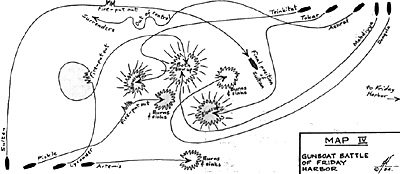 Concentrated fire from three Mahdist boats set HMS Pickle on
fire, but the men were able to put out the blaze. The Tokar received
an accurate and close range blast from the Lysander on turn five,
one shell finding the ammunition locker, sending the Mahdist gunboat
to the bottom in one tremendous explosion. On turn six, the Ashraf
surrendered, still out of control. The unlucky Pickle was again set
afire and this time the men were unable to control it and she was
abandoned; Commodore Fiddler-Crabbe apparently going down with his ship.
Concentrated fire from three Mahdist boats set HMS Pickle on
fire, but the men were able to put out the blaze. The Tokar received
an accurate and close range blast from the Lysander on turn five,
one shell finding the ammunition locker, sending the Mahdist gunboat
to the bottom in one tremendous explosion. On turn six, the Ashraf
surrendered, still out of control. The unlucky Pickle was again set
afire and this time the men were unable to control it and she was
abandoned; Commodore Fiddler-Crabbe apparently going down with his ship.
Before going down, however, the Pickle got revenge by sending a 9" shell into the ammo room on the Tokar, blasting the previously unscathed Mahdist vessel into thousands of small pieces of lumber and metal. On the next turn, the tiny Mahdiyya challenged the much larger Lysander by pulling close alongside to exchange fire. The Mahdist fire was mostly ineffective, but the Lysander's shell fire blew up the tiny Mahdist gunboat. Surprisingly, however, the Mahdiyya had the last laugh as her explosion touched off the Lysander's magazine and both gunboats blew up and sank.
All of a sudden only two ships remained in fighting trim, the Egyptian Sultan and the Mahdist Dongola. They closed on each other rapidly and,'on turn nine, the Dongola was set on fire and burned to the waterline. Captain Abbas of the Sultan now put a prize crew aboard the surrendered Ashraf and both boats sailed into Friday Harbor late on the night of 12 March, 1885. Quickly, and with as little public disturbance as possible, Captain Abbas and a squad of Egyptian infantry marched straight to General Gordon's palace. General Gordon was informed that he was to return to Victoria on the gunboats. If he would not go voluntarily, Captain Abbas informed him that he had orders to place the General under arrest. Confronted with these choices, General Gordon quickly gathered together his personal items and papers, wrote orders to Biscay Bey, the senior Egyptian officer at Friday Harbor (who would assume command of the city) and quietly left the city and boarded the Sultan for the trip back to Victoria.
In less than a month, Friday Harbor fell and all of the San Juans were under the control of the Mahdists. General Gordon had been rescued, so the British Government decided that, for the time being, the Mahdi and his followers could have the islands.
This ends the first part of "The Rise and Fall of the False Prophet of the San Juans". With some luck, the story of the reconquest will appear in some future issues of THE COURIER.
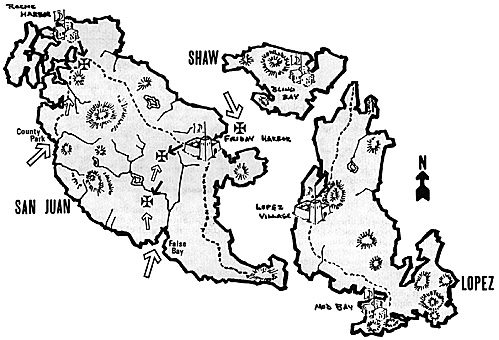
More San Juan Campaign:
- San Juan Campaign, Part I: Background
San Juan Campaign, Part I: Campaign Start
San Juan Campaign, Part II: Mahdist Mania
San Juan Campaign, Part III: Campaign Ends
The Sudan: Military History
-
The Sudan Part I: Introduction: The Mahdi
The Sudan: First British Involvement 1884-85
The Sudan: Anglo-Egyptian Sudan Map
The Sudan: Illustration: Troop Types of Hicks' Expedition (slow: 139K)
Sudan War Bibliography
Lynn Bodin: Bio of Theme Editor for Sudan
Whalers on the Nile: Sudan Transport Boats
Wargame Figures for the Sudan
Colonial Era Wargame Rules Overview
Sudan Part II: The Khalifa Takes Control, 1885
Sudan Part II: The Invasion of Egypt, 1889
Sudan Part II: The Dongala Expedition, 1896
Sudan Part II: Advance to Omdurman, 1897
Sudan Part II: Battle of Omdurman, 1898
Mahdist Armies: Introduction
Mahdist Armies: Early Battles and Uniforms 1883-1885
Mahdist Armies: Later Battles and Uniforms 1889-1898
Back to Table of Contents -- Courier Vol. V #6
To Courier List of Issues
To MagWeb Master Magazine List
© Copyright 1984 by The Courier Publishing Company.
This article appears in MagWeb (Magazine Web) on the Internet World Wide Web.
Other military history articles and gaming articles are available at http://www.magweb.com